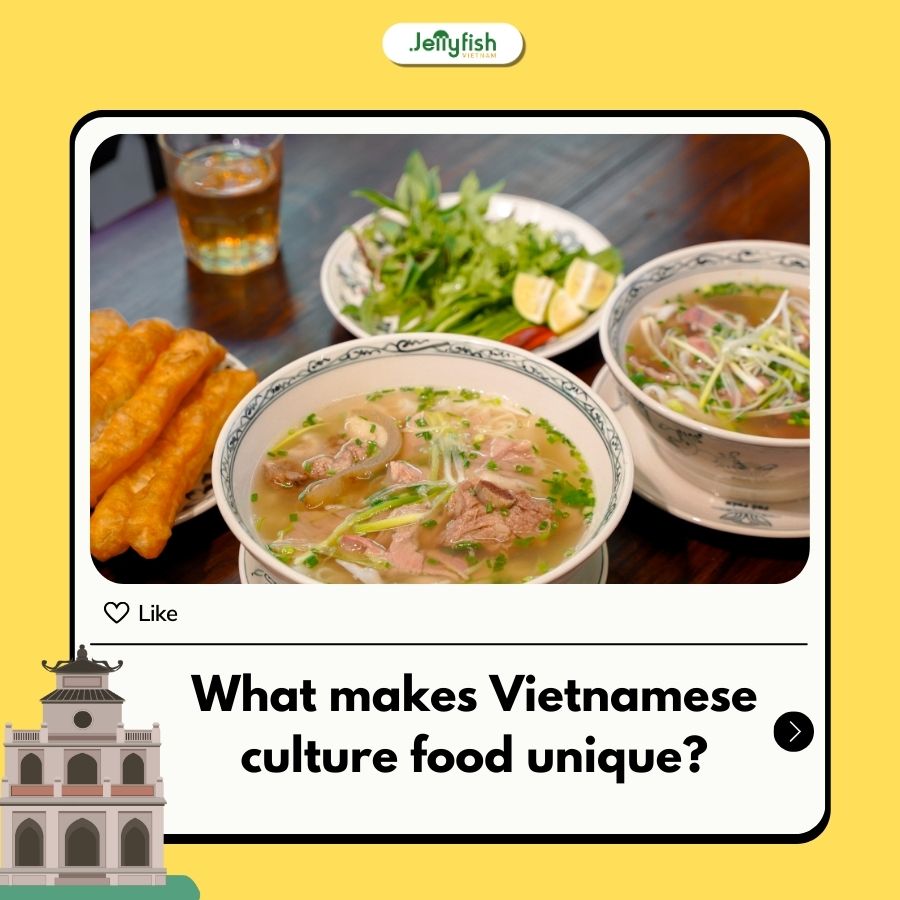Vietnamese cuisine is much more than delicious street food — it’s a gateway to understanding the nation’s values, history, and lifestyle. In this article, Jellyfish Việt Nam explores how Vietnamese culture food reflects the country’s traditions through taste, texture, and philosophy.
1. The philosophy behind Vietnamese food
At the heart of Vietnamese culture food is balanced — in taste, temperature, texture, and nutrition. Influenced by traditional Eastern philosophies like yin-yang and the five elements, Vietnamese meals are designed to be both flavorful and harmonious.
You’ll often find meals combining:
- Saltiness from fish sauce
- Sweetness from sugar or coconut waterSourness from lime or tamarind
- Heat from chili
- Freshness from herbs like mint or coriander
This harmony represents not only good taste but also the Vietnamese mindset: calm, thoughtful, and deeply connected to nature.
2. How daily meals reflect Vietnamese culture
A typical Vietnamese home-cooked meal says a lot about family values and daily life. The meal is usually shared by everyone at the table and includes:
- Steamed rice (cơm)
- A savory main dish (meat, tofu, or fish)
- A bowl of clear soup (canh)
- A dipping sauce, often based on fish sauce with garlic and chili
In Vietnamese culture food, the focus is less on large portions and more on variety, freshness, and family bonding. Meals are moments of connection and respect between generations.

3. Iconic dishes that represent Vietnamese culture food
Some dishes have become symbols of Vietnamese identity both at home and abroad. These include:
- Phở – A national treasure made with hours-simmered broth, rice noodles, and herbs
- Bánh mì – A delicious fusion of French bread and Vietnamese ingredients
- Bún chả – Grilled pork with noodles, famously enjoyed by Obama in Hanoi
- Gỏi cuốn (spring rolls) – Light, fresh rolls dipped in peanut or fish sauce
- Cơm tấm – Broken rice with grilled meat, eggs, and pickles — a southern favorite
These dishes showcase the diversity and richness of Vietnamese culture food, from Hanoi to Ho Chi Minh City.
4. Food in festivals and spiritual life
In Vietnam, food is an important part of spiritual rituals and national celebrations. During the Lunar New Year (Tết), families prepare:
- Bánh chưng & bánh tét – Symbolizing earth and sky
- Pickled onions and vegetables – Representing renewal and health
- Candied fruit – A sweet offering to ancestors
Outside of holidays, food is offered during ancestor worship ceremonies (giỗ), weddings, and important life events. Vietnamese culture food isn’t just for eating — it’s a way to express respect and memory.
5. Street food: everyday culture in every bite
To truly understand Vietnamese culture food, walk through any city street. You’ll find small stalls selling breakfast phở, lunchtime bún bò, or late-night bánh tráng nướng.
Why street food matters:
- It’s affordable and full of local flavor
- It reflects regional specialties and family recipes
- It brings people together in informal, lively ways
Street food is where the culture breathes — quick, social, and full of stories.
See more: Vietnamese drinks with alcohol
Conclusion
From the family dinner table to a sidewalk vendor in Saigon, Vietnamese culture food is about more than flavor — it’s about connection, tradition, and pride. Every dish tells a story of balance, community, and heritage.
Learn Vietnamese through culture with Jellyfish Việt Nam
Understanding Vietnamese culture food is just the beginning to truly connect with the people and traditions of Vietnam, learning the language is essential. At Jellyfish, we offer Vietnamese courses designed specifically for foreigners who want to go beyond travel or food and build real cultural understanding.
Our courses include:
- Thematic lessons built around food, family, festivals, and everyday life
- Native-speaking teachers with practical communication focus
- Flexible schedules, both online and in-person
👉👉 Learning Vietnamese – Jellyfish Vietnam
✦ Hotline: 096 110 6466
✦ Head office: 1st Floor, Web3 Tower Building, Alley 4 Duy Tan Street, Cau Giay District, Hanoi
✦ Branch office: 2rd Floor, SH5.11 Vinhomes Marina, Vinh Niem, Le Chan, Haiphong
✦ Head office in Japan: 4F Westhill Building, Nishigotanda 2-24-4, Shinagawa, Tokyo, Japan


